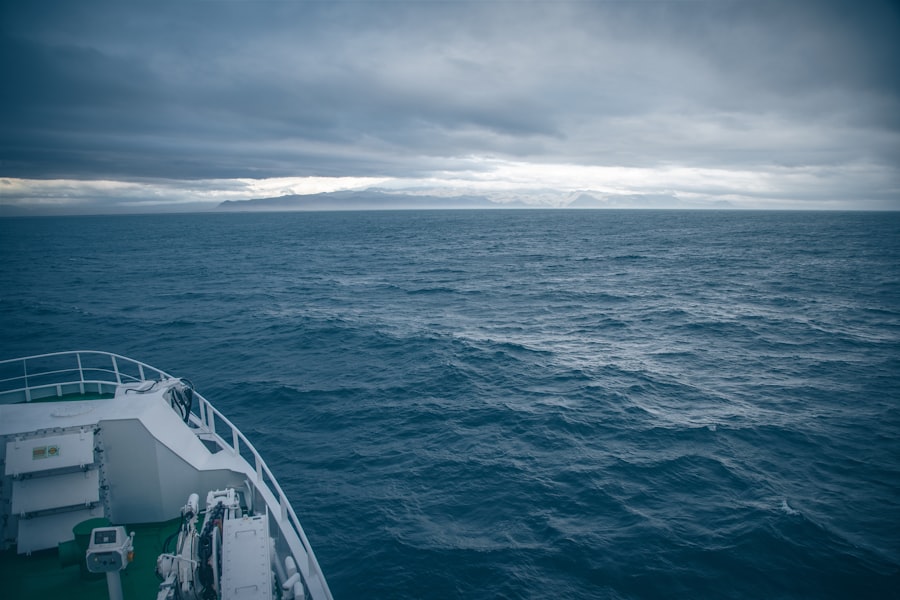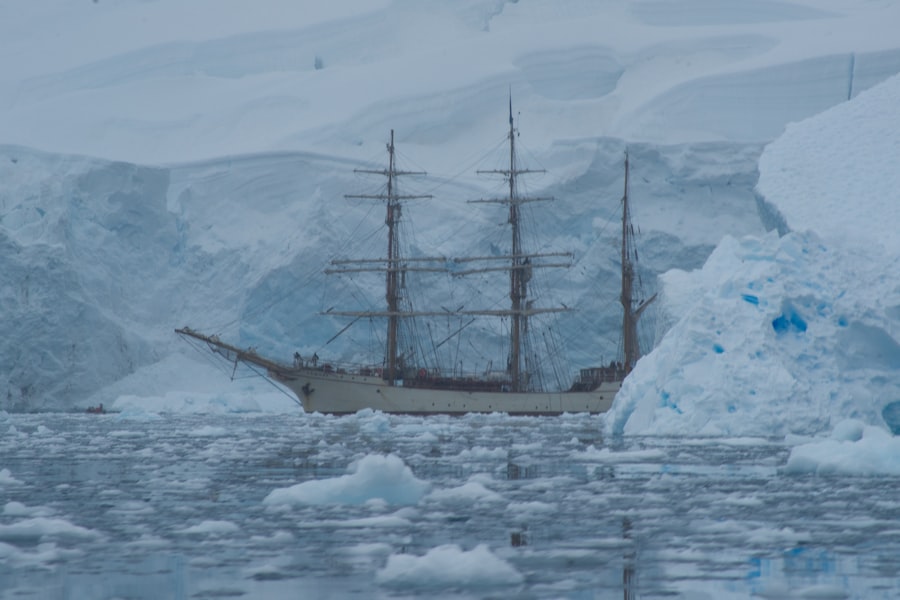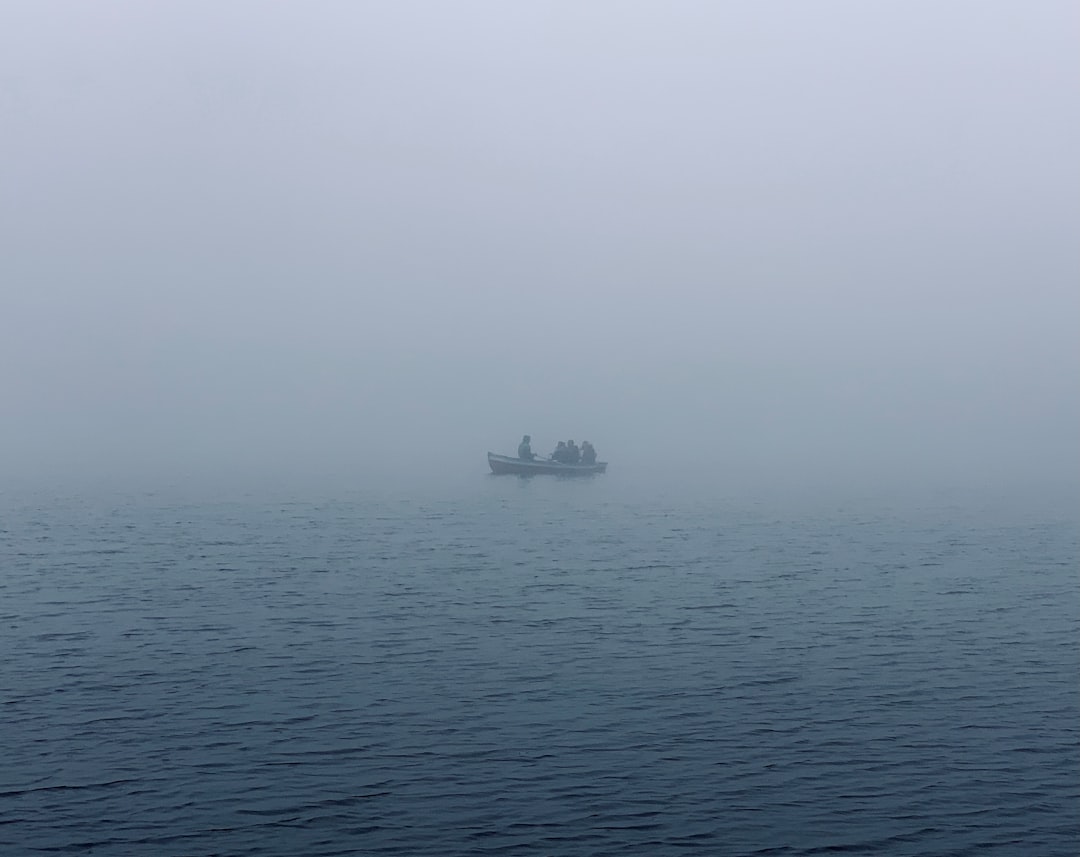The Drake Passage, a body of water situated between the southern tip of South America and Antarctica, is renowned for its tumultuous seas and unpredictable weather patterns. Stretching approximately 600 miles, this passage serves as a critical maritime route for vessels navigating between the Atlantic and Pacific Oceans. Named after the English explorer Sir Francis Drake, who was the first to sail through these waters in the late 16th century, the Drake Passage has become synonymous with both adventure and peril.
Its reputation as one of the most treacherous stretches of ocean in the world is well-deserved, as it is characterized by strong currents, high winds, and massive waves that can reach heights of over 30 feet. The Drake Passage is not only significant for its geographical features but also for its ecological importance. It is home to a diverse array of marine life, including whales, seals, and various species of fish.
The nutrient-rich waters support a vibrant ecosystem that attracts researchers and tourists alike. However, the beauty of this region is often overshadowed by its dangers. The combination of harsh weather conditions and the remoteness of the area has led to numerous maritime incidents, making it a focal point for discussions about safety at sea and the mysteries that lie beneath its surface.
Key Takeaways
- The Drake Passage is a treacherous body of water located between South America’s Cape Horn and the South Shetland Islands of Antarctica.
- The history of mysterious disappearances in the Drake Passage dates back to the early days of maritime exploration, with numerous ships and aircraft vanishing without a trace.
- Theories and speculations surrounding the disappearances range from extreme weather conditions and strong ocean currents to magnetic anomalies and even supernatural forces.
- Notable cases include the 1845 disappearance of the HMS Erebus and HMS Terror during the ill-fated Franklin Expedition, as well as the vanishing of the SS Marine Sulphur Queen in 1963.
- Environmental factors such as unpredictable weather patterns, icebergs, and rough seas contribute to the dangerous nature of the Drake Passage, making search and rescue efforts extremely challenging.
History of Mysterious Disappearances
Throughout history, the Drake Passage has been the site of numerous mysterious disappearances that have captivated the imaginations of sailors, historians, and adventurers. The unpredictable nature of the waters has led to countless ships vanishing without a trace, leaving behind only questions and speculation. One of the earliest recorded incidents occurred in the 19th century when several whaling ships were reported missing during their voyages through these perilous waters.
The harsh conditions and sudden storms often caught crews off guard, leading to catastrophic outcomes. As time progressed, more modern vessels have also succumbed to the dangers of the Drake Passage. The disappearance of ships has often been attributed to a combination of navigational errors, mechanical failures, and the sheer ferocity of the ocean itself.
However, these explanations do little to quell the intrigue surrounding these incidents. The stories of lost ships have become part of maritime folklore, with many sailors sharing tales of ghostly apparitions and eerie phenomena that seem to haunt the waters. These accounts have contributed to a growing body of literature exploring the enigmatic nature of the Drake Passage and its role in maritime history.
Theories and Speculations

The mysterious disappearances in the Drake Passage have given rise to a plethora of theories and speculations regarding their causes. Some experts attribute these incidents to natural phenomena such as rogue waves or sudden storms that can arise with little warning. The unique geography of the passage creates conditions that can lead to violent weather changes, making it difficult for even experienced sailors to navigate safely.
This theory is supported by numerous accounts of vessels being overwhelmed by towering waves that seem to appear out of nowhere. On the other hand, some theories delve into more supernatural explanations. The idea that the Drake Passage is a site of paranormal activity has gained traction among those fascinated by the unexplained.
Stories abound of ghost ships and spectral sailors who wander the waters, forever trapped in a cycle of despair. While these tales may lack scientific backing, they continue to capture the imagination and fuel speculation about what truly lies beneath the surface of this treacherous passage.
Notable Cases
| Case Name | Year | Outcome |
|---|---|---|
| O.J. Simpson Trial | 1995 | Acquitted of murder charges |
| Roe v. Wade | 1973 | Legalized abortion in the US |
| Brown v. Board of Education | 1954 | Declared state laws establishing separate public schools for black and white students to be unconstitutional |
Among the many disappearances in the Drake Passage, several notable cases stand out due to their mysterious circumstances and lasting impact on maritime lore. One such case is that of the fishing vessel “M.
Taimyr,” which vanished in 1985 while en route to Antarctica. Despite extensive search efforts, no trace of the ship or its crew was ever found, leading to widespread speculation about what could have happened. The incident remains one of the most perplexing maritime mysteries in recent history.
Another infamous case involves the “S.S. Orizaba,” a cargo ship that disappeared in 1942 under similarly enigmatic circumstances. Reports suggest that the vessel encountered severe weather conditions before vanishing without a trace.
The lack of debris or distress signals has led many to wonder if something more sinister occurred during its final moments at sea. These cases serve as reminders of the dangers inherent in navigating the Drake Passage and highlight the need for continued vigilance in maritime travel.
Environmental Factors

The environmental factors contributing to the dangers of the Drake Passage are multifaceted and complex. The convergence of cold Antarctic waters with warmer currents from the north creates a volatile mix that can lead to sudden weather changes. This phenomenon is exacerbated by the passage’s unique topography, which includes underwater ridges and deep trenches that can influence wave patterns and currents.
As a result, sailors must remain vigilant and prepared for rapidly changing conditions that can turn a calm sea into a raging tempest in mere moments. Additionally, climate change has begun to play a role in altering the environmental dynamics of the Drake Passage. As global temperatures rise, ice melt from Antarctica contributes to changes in ocean currents and weather patterns.
This shift may lead to an increase in extreme weather events, further complicating navigation through these already treacherous waters. Understanding these environmental factors is crucial for improving safety measures and ensuring that future maritime endeavors in the Drake Passage are conducted with greater awareness of potential risks.
Search and Rescue Efforts
In response to the numerous disappearances in the Drake Passage, search and rescue efforts have evolved significantly over time. Initially, these operations relied heavily on local knowledge and rudimentary technology, often resulting in limited success. However, advancements in satellite technology and communication systems have transformed search efforts into more coordinated and efficient operations.
Modern search teams can now deploy aircraft and vessels equipped with advanced tracking systems to cover vast areas more effectively. Despite these advancements, challenges remain in conducting search and rescue missions in such a remote and unpredictable environment. The harsh weather conditions can hinder operations, making it difficult for rescuers to reach distressed vessels in a timely manner.
Additionally, the vastness of the Drake Passage means that even with modern technology, locating a missing ship can be akin to finding a needle in a haystack. Nevertheless, ongoing efforts continue to improve response times and enhance safety protocols for those navigating these perilous waters.
Supernatural Explanations
The allure of supernatural explanations surrounding disappearances in the Drake Passage has captivated many over the years. Some believe that ancient maritime legends speak of cursed waters or vengeful spirits that claim ships as their own. These tales often draw upon local folklore and historical accounts of sailors who have encountered strange phenomena while traversing these treacherous seas.
Ghostly apparitions or mysterious lights on the horizon have been reported by those who claim to have witnessed them firsthand. While skeptics may dismiss these stories as mere superstition, they continue to resonate with those who seek answers beyond scientific reasoning. The idea that there may be forces at play beyond human understanding adds an element of intrigue to an already mysterious environment.
Whether one subscribes to these supernatural beliefs or not, they undeniably contribute to the rich tapestry of narratives surrounding the Drake Passage and its enigmatic reputation.
Survivors’ Accounts
Survivors’ accounts from those who have braved the Drake Passage provide invaluable insights into the challenges faced by sailors navigating these tumultuous waters. Many recount harrowing experiences marked by fierce storms and towering waves that tested their resolve and skill. One survivor described being tossed about like a toy in a bathtub as their vessel struggled against relentless winds and swells that seemed insurmountable.
Such firsthand accounts serve as stark reminders of nature’s power and unpredictability. In addition to recounting their struggles against physical challenges, survivors often share stories of camaraderie among crew members during times of crisis. The bonds forged in adversity can be profound, as sailors rely on one another for support and encouragement when faced with life-threatening situations.
These narratives not only highlight individual resilience but also underscore the importance of teamwork in overcoming obstacles at sea.
Impact on Maritime Travel
The dangers associated with navigating the Drake Passage have had a significant impact on maritime travel over the years. For many shipping companies and cruise lines, safety remains a top priority when planning routes through this region. As a result, some vessels opt for alternative paths that may be longer but offer greater protection from unpredictable weather patterns.
This shift has implications for trade routes and tourism, as travelers seek safer options while still desiring access to remote destinations. Moreover, increased awareness of potential risks has led to enhanced training programs for crews operating in challenging environments like the Drake Passage. Sailors are now better equipped with knowledge about weather patterns, navigation techniques, and emergency protocols designed specifically for these treacherous waters.
As maritime travel continues to evolve, understanding how to navigate safely through such perilous regions remains crucial for ensuring both passenger safety and operational efficiency.
Government Investigations
In light of numerous disappearances within its waters, government investigations into incidents occurring in the Drake Passage have become increasingly common. Maritime authorities often conduct thorough inquiries following significant events to determine causes and prevent future occurrences. These investigations typically involve analyzing data from vessel tracking systems, interviewing survivors or witnesses when possible, and reviewing weather reports from relevant timeframes.
While some investigations yield clear conclusions regarding navigational errors or mechanical failures, others remain inconclusive due to lack of evidence or conflicting testimonies. Nevertheless, these efforts play an essential role in enhancing safety regulations within maritime travel industries operating in this region. By learning from past incidents through rigorous investigation processes, authorities aim to mitigate risks associated with navigating one of Earth’s most formidable bodies of water.
Conclusion and Future Implications
The Drake Passage remains an enigmatic region steeped in mystery and danger, captivating those who dare to traverse its tumultuous waters. From historical disappearances to modern-day challenges posed by environmental factors and supernatural speculations, this passage continues to evoke intrigue among sailors and researchers alike. As advancements in technology improve search and rescue efforts while enhancing safety protocols for maritime travel, it is crucial for those navigating these waters to remain vigilant.
Looking ahead, ongoing research into climate change’s impact on ocean dynamics will be vital for understanding how future conditions may alter navigation through this region further still. By fostering collaboration between scientists, maritime authorities, and sailors themselves—those who know these waters best—there lies hope for safer journeys across one of nature’s most formidable passages: The Drake Passage.
The Drake Passage, a notorious stretch of water between the southern tip of South America and Antarctica, has long been a site of intrigue and mystery, particularly due to the numerous ships that have gone missing in its treacherous waters. For those interested in exploring more about the challenges and historical significance of this maritime route, a related article can be found on MyGeoQuest. This article delves into the geographical and historical aspects of the Drake Passage, providing insights into why it remains one of the most formidable passages for sailors.
com/sample-page/’>link.
WATCH NOW! Drake Passage: Earth’s Deadliest Waters Revealed
FAQs
What is the Drake Passage?
The Drake Passage is the body of water between the southern tip of South America and the northern tip of the Antarctic Peninsula. It is known for its rough seas and challenging sailing conditions.
Why is the Drake Passage known for missing ships?
The Drake Passage is known for its unpredictable and severe weather conditions, including strong winds, high waves, and frequent storms. These conditions make it a hazardous area for ships to navigate, leading to the potential for ships to go missing.
How many ships have gone missing in the Drake Passage?
There have been several documented cases of ships going missing in the Drake Passage over the years. The exact number is difficult to determine, but the treacherous nature of the passage has led to a number of maritime incidents.
What are the potential causes of ships going missing in the Drake Passage?
Ships can go missing in the Drake Passage due to a combination of factors, including extreme weather, navigational challenges, icebergs, and the remote and isolated nature of the area. These factors can make it difficult for search and rescue efforts to locate missing ships.
What measures are in place to improve safety in the Drake Passage?
To improve safety in the Drake Passage, ships and vessels are equipped with advanced navigation and communication systems. Additionally, weather forecasting and monitoring systems help to provide early warnings of potential hazards. However, the passage remains a challenging and unpredictable environment for maritime travel.
